-
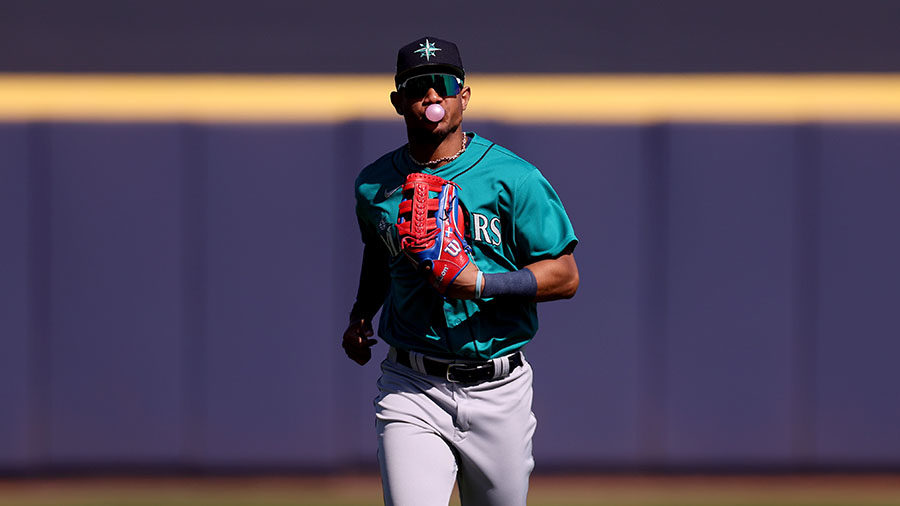 March 19, 2024, 1:58 pm
March 19, 2024, 1:58 pmLast Updated on July 3, 2025 9:35 pm by Anthony Kates | Published: March 19, 2024
I’ve been playing fantasy baseball in some form or fashion since 1998, but none of those leagues could prepare me for “The Great Fantasy Baseball Invitational” (or TGFBI, if you will). I’ve played in leagues with as few as eight teams all the way up to 30 teams, I’ve played in head-to-head categories and roto leagues. I’ve played in re-draft, keeper, and dynasty leagues. They all pale in comparison to TGFBI.
Let’s back up a little bit here and let me explain what TGFBI is. TGFBI is a massive fantasy baseball contest that includes players from all walks of the fantasy baseball industry and a handful of satellite league winners, created and ran by fantasy baseball powerhouse, Justin Mason (@JustinMasonFWFB on Twitter/X; writer/podcaster for Fangraphs; owner of FriendswithFantasyBenefits; writer for FantasyPros). Justin works with Rotowear to create custom shirts every year, with a portion of every shirt sold going to the charity “Fantasy Cares.” More money is raised for the charity from those who wish to enter the satellites, as a donation to “Fantasy Cares” is required for entry (as big or as little as you can afford) and also throughout Podapallooza, two days filled with live podcasts featuring analysts, writers, podcasters, etc. from all over the fantasy baseball industry.
I have tried twice before to get into TGFBI, trying the satellite leagues route. The first year (2022) I finished in 12th place. The second year, a bit desperate and in need of someone to keep me grounded, I found a co-manager willing to be bothered by 2 am text messages and hour long phone calls over which platoon bat we should draft in round 28. This resulted in a 5th-place finish, which, yes, was closer to the top, but was not a victory.
So, I decided on an “easier” route to entry: I joined the fantasy baseball industry, by creating written content for this website, SportsEthos. I started last year, writing one little article a week, the Saturday “Daily Pickups” article, whereas this year, so far, I have written the entirety of the dynasty rankings for our draft guide and have more dynasty focused articles on the way.
Now, here we are. Post-draft, a few days away from the Dodgers and Padres playing a two-game series in Korea and two weeks away from opening day for the rest of the league. We’re going to step into my TGFBI league and look at the picks I made and why I made them, with a little commentary on others’ picks along the way.
(Quick Note: this draft started on February 26th and ended in the first week of March)
Rounds 1 through 5:
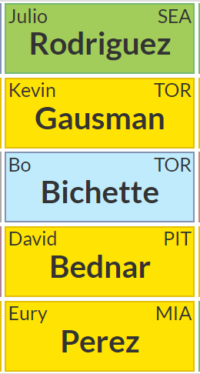
I drafted from the 3-spot, which is where I wanted to draft from. Acuna goes first, then I get to let the second drafter make my decision easy: they either choose Bobby Witt, Jr. or Julio Rodriguez, and then I choose the other. I wanted a 40/40 threat with my first pick and I got it. In the second round, I wanted a staff ace. With 15 teams in the league, pitching goes much sooner than it does in shallower leagues, so Gausman was the fifth pitcher off the board and he was immediately followed up by Luis Castillo and Zac Gallen. In the third, I “reached” for Bo by a few picks, but I wanted to grab a top shortstop, because there is a large drop-off, in my opinion, after the top 6 or 7 guys. Bednar in the fourth in most leagues would seem kind of crazy, but in TGFBI leagues (and most of the big-money NFBC leagues), high-end closers go very early (and Bednar was the seventh closer off the board; nine were drafted in the first five innings alone). In my previous two TGFBI satellite attempts, I went bat-heavy and usually didn’t draft an arm until the 5th or 6th inning, so I decided to switch it up for the real thing, making Eury Perez the third arm I selected in the first five rounds. I absolutely love Eury and truly feel like he will finish as a top-ten pitcher this season if the Marlins let him throw 150 or more innings. Interestingly, Fried went three picks later, but no SP was chosen again until Blake Snell in the sixth round, thirteen picks later.
Rounds 6 through 10:
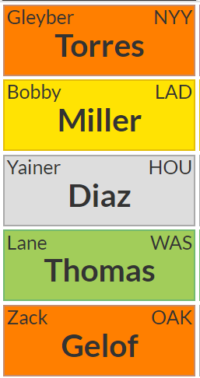
Grabbing Gleyber in the sixth is when I really started to lean towards a hitting draft philosophy of grabbing as many players as possible that will hit 20 or more home runs while also stealing 10 or more bases. I also grabbed him because he is criminally underrated and I think the Yanks are going to score a ton of runs this year and he will play a big part in why they do. I knew going into my pick in the 7th round that I wanted to take a pitcher, I just wasn’t sure whether that would be a closer or a starter. In hindsight, I probably should have targeted a closer, instead of choosing Bobby Miller. This has nothing to do with Miller, just where I wound up with only one legit closer and praying I find more from other picks or off the waiver wire. At the time though, I loved the Bobby Miller pick, as that was the latest he was drafted in any TGFBI league (the next closest was 81st). In fact, in 26 out of the 28 drafts, he was selected between picks 56 and 78. Yainer Diaz was the fifth catcher selected and he went later in only two of the other TGFBI drafts. It was a homer pick, as I wanted to make sure I got at least one of the 5 or 6 best Astros players, but also good value, as I believe with 500 or so plate appearances (split between C and DH) he can put up 30 home runs, with 60-70 runs 90+ RBI and a solid average. After Diaz was another of the 20/10 mold, in Lane Thomas. Coming off of an age-27 breakout, Thomas is in line to once again bat leadoff for the Nationals and set the pace for the offense. Another 20/20 season would not surprise me. I was able to grab Gelof a full round later than his ADP, rounding out my MI position with another potential 20/20 performer. I had hoped to grab one of three other players at this spot (Ober, O’Hoppe, or Evan Carter), but all three were snapped up before this pick.
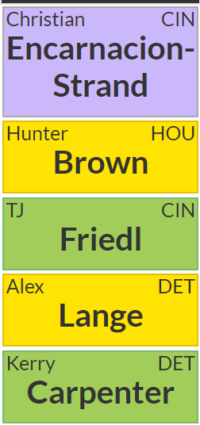
With the 11th pick, I had considered grabbing one of the young arms but decided to focus on my corner infield positions and pray that one dropped to me. Though I do not celebrate the Noelvi Marte suspension, it pretty much guarantees that CES will be starting at 1B for at least half of, if not the entirety of, the season, so I am happy that I was able to grab him here. In the 12th I was able to grab the last of the young arms I was targeting, with Hunter Brown. Obvious Astros bias, but everyone says he looks like Justin Verlander on the mound, from his presence on the mound to his blazing fastball, and I am betting on him being better than he was down the stretch in 2023. This being a 15-team league and going 5 deep with starting outfielders, I felt it was time to take my third starter and was glad to see TJ Friedl sitting there for me. He follows my pattern of grabbing players who have the upside to go 20/20 or better in a season. In the 14th I realized I had waited too long to grab a second closer (and I had just watched the top player in my queue, Mason Miller, get snapped up right before my pick), so I took the best of the remaining “closers”. I don’t know if he will close all season, but I think he should do a decent job and get 25+ saves for an improving Tigers team. Banking on that improvement, I dipped back into the Tigers well with the Carpenter pick in round 15. He hit 36 home runs over three levels in 2022 and then hit 20 in 459 big league plate appearances last year. Give this man 600 plate appearances and I bet we’ll get 25 to 30 home runs out of him.
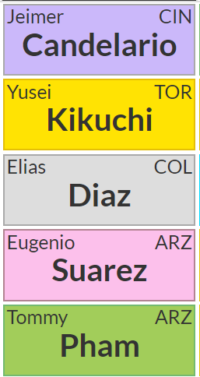
I realized I had not addressed nor focused on 3B at all, so I decided to grab another piece of what I hope is an exciting Reds offense, snapping up the presumable starting 3B in Jeimer Candelario. The Noelvi Marte suspension gives Candy-man quite a bit of room to run away with staying in the lineup all season (I made this pick before Matt Chapman signed with the Giants; had I known that was going to happen I would have selected him instead). Kikuchi is coming off his best season in the majors, having lowered his walk rate, home run rate, hard hit rate, and barrel rate, while striking out a batter per inning while attacking the zone a bit more than he did in 2022. I’m banking on him being healthy and maintaining his gains for a Blue Jays team that is going to do their best to be competitive all season long. In leagues where you start two catchers, it’s very rare that your second catcher is all that great. Sure, Elias Diaz was an All Star last year, but he was much worse in the second half than he was in the first. I’m hoping here to get that good first half and keep my ear to the ground for a catching upgrade somewhere else. Eugenio Suarez is a guy I’ve always enjoyed watching play, because I know he’s going to do two things I enjoy: play great defense and hit home runs. He has hit 20 or more home runs in seven straight, non-covid seasons (and he hit 15 home runs in 57 games in 2020, so this would have been his eighth season in a row). He might hit closer to thirty this year, as the Mariners stadium is one of the worst for right-handed hitters. You might see that Pham pick and think, “Oh, he’s an insider, he must know something we don’t”. I don’t. It was a mis-click, added to my queue after a very long day of work, and not noticed until he was auto-picked for me the following day. He will be dropped during the first round of FAAB pick-ups unless he signs with someone *cough* San Diego *cough* before then.
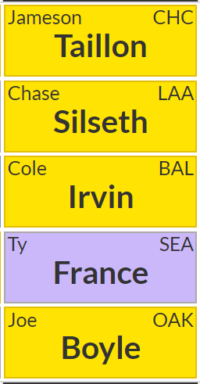
We are now 300 picks into the draft, so from here on out I don’t really consider any pick as a reach or going later than they should. As you can tell, only one of these five picks was a bat and that is intentional. Once I have my starters set (though I need to replace Pham), I start looking for young arms, bounce-back candidates, and guys who are fighting for a spot in the rotation, to fill out the back end of my rotation and bench. Taillon is a steady veteran, someone I will play matchups with. Silseth, Irvin, and Boyle are all fighting for a spot in their team’s rotation and all have upside with some warts. Namely, most struggle with throwing strikes and walking too many batters, but have strikeout-per-inning upside and could swing 8-10 wins this season. Ty France is a boring veteran in a very good offense that still has 25+ home run potential. The perfect guy to grab this late.
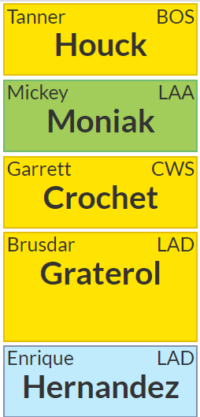
Rounds 26 through 30 are dart throws, reliever gambles, and depth plays. Moniak gives me a viable OF backup and someone to start in place of Pham and Hernandez gives me some stats from the Korea series while also giving me a backup at 2B and SS. Houck and Crochet are bets that they can recoup the stamina and strength to make it as solid starters. If not, they can be multi-inning bullpen guys that help to pad my W, SO, and ratio pitching categories. The Graterol pick is just having him as the potential Dodgers closer if Evan Phillips performs poorly or gets injured. Even if he doesn’t, he will still contribute positively to my ratios while grabbing a handful of wins and the occasional save.
I will post an update article once a month once the season starts (first week of May), sharing the performance of the team and any moves I’ve made, as well as discussing all of the decisions I make throughout the season for this team. Here’s to fighting for first in my TGFBI and placing well in the overalls!!

